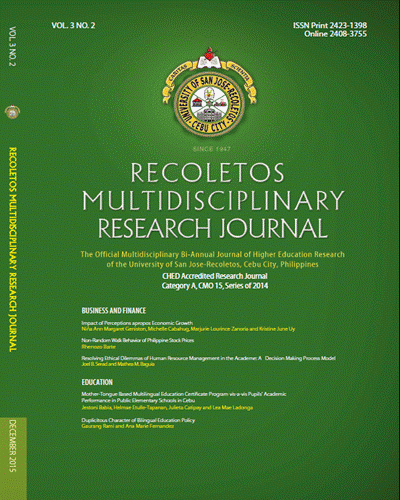Levels of Multidrug-Resistant Tuberculosis Treatment Success among ASEAN Countries
DOI:
https://doi.org/10.32871/rmrj1503.02.11Keywords:
Multidrug-resistant tuberculosis (MDR-TB), multivariate cluster analysis, principal component analysis, health expenditure, adult literacy rateAbstract
Health expenditure of a country is intended to finance medicines and other medical services and assistance for those people affected with diseases especially those communicable ones. The global issue of tuberculosis has been a well-known communicable disease which could result in another type of such disease, if untreated. This study is conducted to assess the treatment success of multidrug-resistant tuberculosis (MDR-TB) cases, which had been a burden for countries in terms of financial aspects. Through the use of multivariate cluster and principal component analyses, ASEAN countries were grouped and ranked from very highly successful to least successful in the level of treatment success which would provide comprehensive findings as to what ASEAN country successfully provides financial to their diagnosed patients. Further, it was found out that the level of success of MDR-TB treatments among ASEAN countries varies inversely with the number of patients undergoing the treatment while directly proportional to the amount of investments in health expenditures. Hence, MDR-TB treatment success depends on the level of amount of investments for health the ASEAN country has and the number of patients undergoing the treatment. Thus, the success of the treatment can be achieved at high economic price.
References
Brigden, G., Nyang'wa, B. T., du Cros, P., Varaine, F., Hughes, J., Rich, M., ... & Balasegaram, M. (2014). Principles for designing future regimens for multidrug-resistant tuberculosis. Bulletin of the World Health Organization,92(1), 68-74.
Caminero, J. A. (2005). Management of multidrug-resistant tuberculosis and patients in retreatment. European Respiratory Journal, 25(5), 928-936.
Castillo-Chavez, C., & Feng, Z. (1997). To treat or not to treat: the case of tuberculosis. Journal of Mathematical Biology, 35(6), 629-656.
Chee, C. B., Hsu, L. Y., Sng, L. H., Leo, Y. S., Cutter, J., & Wang, Y. T. (2013). MDR TB Transmission, Singapore. Emerging infectious diseases,19(7), 1151.
Chee, C. B., Khin-Mar, K. W., Cutter, J., & Wang, Y. T. (2012). The imminent threat of multidrug-resistant tuberculosis in Singapore. Singapore medical journal, 53(4), 238-240.
Cutter, J., & Wang, Y. T. (2010). Tuberculosis-an under-appreciated disease. Annals of the Academy of Medicine, Singapore, 39(3), 261.
Enemark, C. (2013). Drug-resistant tuberculosis: Security, ethics and global health. Global Society, 27(2), 159-177.
Espinal, M. A. (2003). The global situation of MDR-TB. Tuberculosis, 83(1), 44-51.
Fisher, M. (2002). Diagnosis of MDR-TB: a developing world problem on a developed world budget. Expert review of molecular diagnostics, 2(2), 151-159.
Goble, M., Iseman, M. D., Madsen, L. A., Waite, D., Ackerson, L., & Horsburgh Jr, C. R. (1993). Treatment of 171 patients with pulmonary tuberculosis resistant to isoniazid and rifampin. New England Journal of Medicine, 328(8), 527-532.
Kent, J. H. (1993). The epidemiology of multidrug-resistant tuberculosis in the United States. The Medical clinics of North America, 77(6), 1391-1409.
Lee, K., Yach, D., & Kamradt-Scott, A. (2011). Globalization and health.
Martin, A., Camacho, M., Portaels, F., & Palomino, J. C. (2003). Resazurin microtiter assay plate testing of Mycobacterium tuberculosis susceptibilities to second-line drugs: rapid, simple, and inexpensive method. Antimicrobial agents and chemotherapy, 47(11), 3616-3619.
Masjedi, M. R., Tabarsi, P., Chitsaz, E., Baghaei, P., Mirsaeidi, M., Amiri, M. V., ... & Velayati, A. A. (2008). Outcome of treatment of MDR-TB patients with standardised regimens, Iran, 2002–2006. The International Journal of Tuberculosis and Lung Disease, 12(7), 750-755.
Migliori, G. B., Besozzi, G., Girardi, E., Kliiman, K., Lange, C., Toungoussova, O. S., ... & Raviglione, M. C. (2007). Clinical and operational value of the extensively drug-resistant tuberculosis definition. European Respiratory Journal, 30(4), 623-626.
Monedero, I., & Caminero, J. A. (2009). MDR-/XDR-TB management: what it was, current standards and what is ahead.
Mukherjee, J. S., Rich, M. L., Socci, A. R., Joseph, J. K., Virú, F. A., Shin, S. S., ... & Seung, K. J. (2004). Programmes and principles in treatment of multidrug-resistant tuberculosis. The Lancet, 363(9407), 474-481.
Ormerod, L. P. (2005). Multidrug-resistant tuberculosis (MDR-TB): epidemiology, prevention and treatment. British medical bulletin, 73(1), 17-24.
Ormerod, L. P. (2005). Multidrug-resistant tuberculosis (MDR-TB): epidemiology, prevention and treatment. British medical bulletin, 73(1), 17-24.
Ormerod, L. P. (2005). Multidrug-resistant tuberculosis (MDR-TB): epidemiology, prevention and treatment. British medical bulletin, 73(1), 17-24.
Quelapio, M. I. D., Tupasi, T. E., Mira, N. R. C., & Gler, M. T. S. (2007). The Philippines case study. Bulletin of the World Health Organization, 85(5), 392.
Sharma, S. K., & Mohan, A. (2006). Multidrug-resistant tuberculosis: a menace that threatens to destabilize tuberculosis control. CHEST Journal, 130(1), 261-272.
Velayati, A. A., Masjedi, M. R., Farnia, P., Tabarsi, P., Ghanavi, J., ZiaZarifi, A. H., & Hoffner, S. E. (2009). Emergence of new forms of totally drug-resistant tuberculosis bacilli: super extensively drug-resistant tuberculosis or totally drug-resistant strains in Iran. Chest Journal, 136(2), 420-425.
Wang, Y., Liu, X., Rui, D., Zhu, M., Zhang, H., Chen, C., ... & Zheng, L. (2014). Detection of mutations associated with resistance to rifampicin and isoniazid in Mycobacterium tuberculosis by polymerase chain reaction-ligase detection reaction. Acta biochimica et biophysica Sinica, 46(1), 78-81.
White, V. L. C., & Moore-Gillon, J. (2000). Resource implications of patients with multidrug resistant tuberculosis. Thorax, 55(11), 962-963
Whittier, K. Ethics, Autonomy and the Treatment of Tuberculosis in Impoverished Patients in India.
World Health Organization. (2008). Anti-tuberculosis drug resistance in the world, fourth global report: the WHO/IUATLD Global Project on Anti-Tuberculosis Drug Resistance Surveillance. World Health Organization.
Downloads
Published
How to Cite
Issue
Section
License
Copyright of the Journal belongs to the University of San Jose-Recoletos


